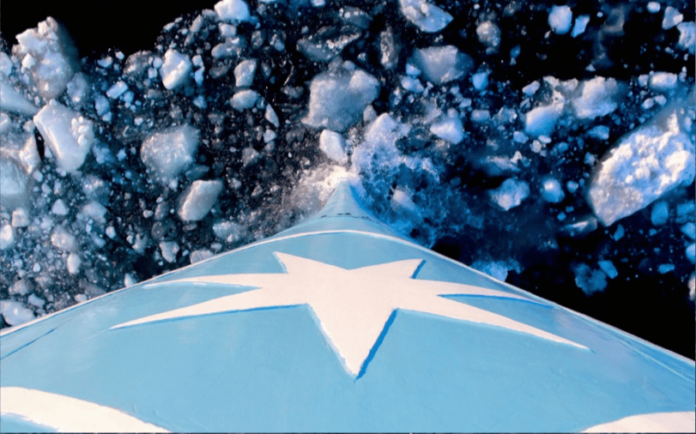“While Venta Mærsk has not been the only vessel crossing through Arctic waters this year, approvals are not automatically granted by the Russian authorities,” explains Michael Meisel, Senior Marine Specialist and project lead of the trial.
“We made it our responsibility to take every possible measure to ensure that this passage was done with the highest considerations for the safety of our seamen and ship as well as with respect for the sensitive environment in the region and its global significance.”
Preparation is key
Maersk turned to the POLAR CODE for guidance. The Code recognizes the importance of additional requirements on ships and their systems when operating in the Arctic waters and was developed to supplement existing instruments by the International Maritime Organisation (IMO) to increase safety of operations as well as mitigate risks for people and environment in the sensitive area of the Arctic and beyond.
Working in close collaboration with the NSR Administration, ice breaker company and other Arctic vessel operators, a feasibility study of the potential route for the one-off trial was undertaken. Ice conditions and weather as well as draught restrictions are important factors on the long list of considerations. Ship structure and every single machinery installations were put to the test. Extra equipment such as night vision binoculars, fuel, provisions and spare parts were stored aboard the vessel and different additional tracking and monitoring systems installed.

The Code also asks for crew members to undergo special training and captains as well as chief officers must undertake an ice navigation course. This however not only applies to the crew onboard Venta Mærsk, but all the senior deck officers on Maersk Line’s new Baltic feeders which operate in the Northern and Baltic sea where winters can be cold and harsh.
They all must attend a course in Finland on the Polar Code and the requirements listed therein along with simulator training in how to navigate in ice, both in Arctic waters and in the Baltics, since each area presents a unique set of challenges.
Although not a regulatory requirement, Maersk decided to use ultra-low sulphur fuel (ULSFO) for this trial. The fuel Maersk purchased was a very high-grade ULSFO, on par with marine distillate oil. In combination with the new two-stroke engine of the vessel, excellent combustion was to be secured and Black Carbon emissions to be limited as much as possible.
Sailing through cold waters
Well prepared, a touch of adventure spirit remained when Captain Søren Bruun, his 25 crew members and two NSR Certified Ice Pilots from Russia set sail.
They passed through Bering Strait on 6 September and the following day they crossed the Arctic Circle, entering the Chukchi Sea and officially sailing in Arctic waters. The crew spent a couple of days frost securing the vessel, starting up heaters, and adjusting the humidity in the accommodation. The weather was good, with temperatures around 0 degrees Celsius and no wind.
During the journey, the aurora borealis made several appearances. “The memory that will last the longest for most of the crew will certainly be the undiluted experience of nature. Most had never seen northern lights and we had four days of perfect floor seats to this spectacular show,” says Captain Bruun.

Venta Mærsk adjusted her route slightly keeping further south to avoid the ice belt to the North of the East Siberian islands. Before entering the East Siberian Sea, she was met by an icebreaker, which would be assisting her through the next section of the Northern Sea Route. The ice breaker crew is familiar with the waters and the environment and therefore the most competent to navigate safely through the waters.
The icebreaker escorted Venta Mærsk through the East Siberian Sea and the Sannikov Strait, where there is very shallow water. Venta Mærsk had left the port of Busan with 660 reefer containers full of frozen fish, leaving her with a draught of 11 meters but was guided safely through the strait where the maximum recommended draught for passing ships is just 11 meters.
On 11 September, vessel and icebreaker parted ways. Venta Mærsk entered the Laptev Sea and thereby the western part of Northern Sea Route. Staying clear of icebergs appearing in the distance, Venta Mærsk proceeded by herself and left the Northern Sea Route on 15 September.
An exceptional experience
Needless to say, Captain Bruun and his crew would not mind taking the vessel for another trip through the Arctic. However, the experience will likely remain unique. While the trial offered an exceptional opportunity to gain operational experience in a new area and to test vessel systems and crew capabilities, currently the Northern Sea Route is not seen as an alternative to the existing east-west routes at Maersk.
New services are planned according to customers’ demand, trading patterns, and population centres. Many different factors are taken into account when planning shipping routes, especially trading patterns and populations centres.

“Operations in the Arctic pose completely different demands on ships and their design. The passage is feasible for around three months during the summer, marked by a lack of obstructive ice. That said, ice conditions can vary and are in general difficult to predict. Thus, assistance by icebreakers which are around to support safe navigation all year will still be necessary,” elaborates Meisel. “Furthermore, we also must consider that ice-classed vessels are required to make the passage. Going forward, there will be more dependency with the Polar Code which would also mean additional investments.”







